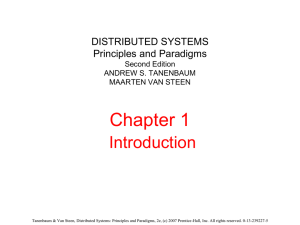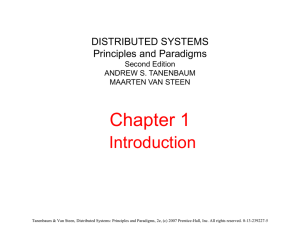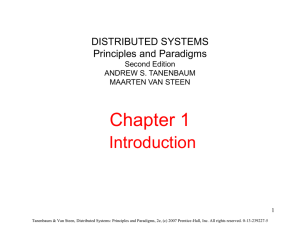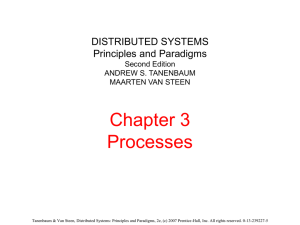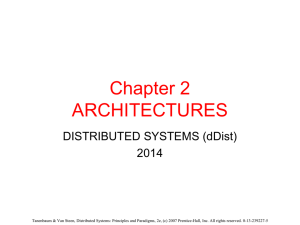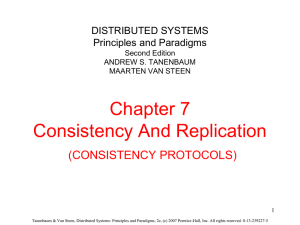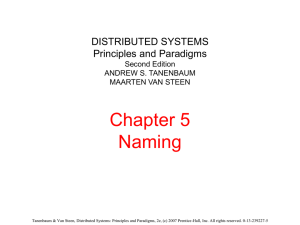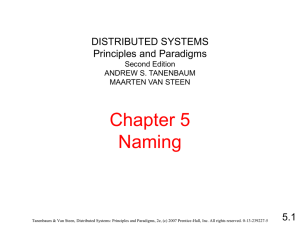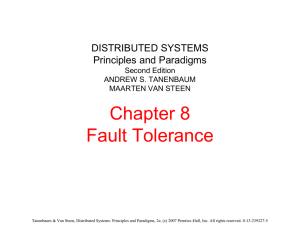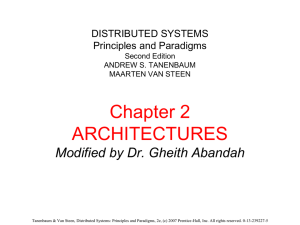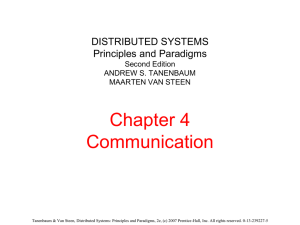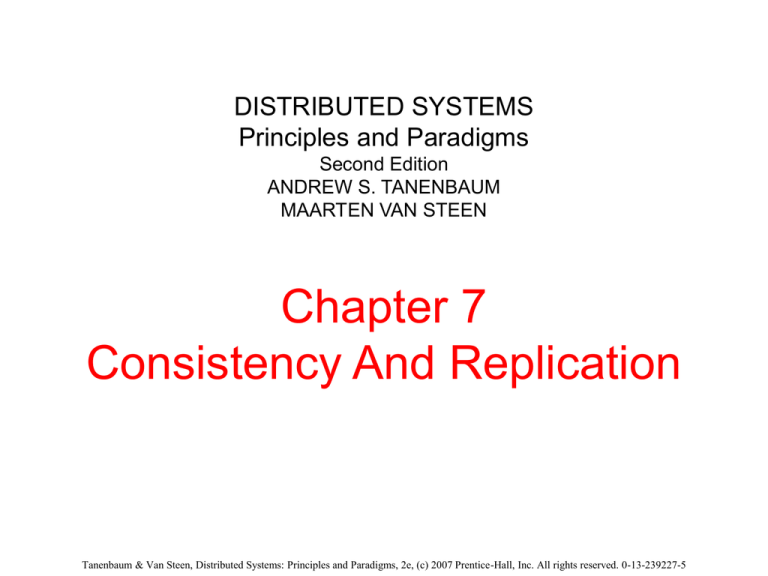
DISTRIBUTED SYSTEMS
Principles and Paradigms
Second Edition
ANDREW S. TANENBAUM
MAARTEN VAN STEEN
Chapter 7
Consistency And Replication
Tanenbaum & Van Steen, Distributed Systems: Principles and Paradigms, 2e, (c) 2007 Prentice-Hall, Inc. All rights reserved. 0-13-239227-5
Reasons for Replication
•
Data are replicated to increase the
reliability of a system.
Replication for performance
•
Scaling in numbers
Scaling in geographical area
Caveat
Gain in performance
Cost of increased bandwidth for
maintaining replication
Tanenbaum & Van Steen, Distributed Systems: Principles and Paradigms, 2e, (c) 2007 Prentice-Hall, Inc. All rights reserved. 0-13-239227-5
Data-centric Consistency Models
Figure 7-1. The general organization of a logical
data store, physically distributed and
replicated across multiple processes.
Tanenbaum & Van Steen, Distributed Systems: Principles and Paradigms, 2e, (c) 2007 Prentice-Hall, Inc. All rights reserved. 0-13-239227-5
Continuous Consistency (1)
Figure 7-2. An example of keeping track of consistency
deviations [adapted from (Yu and Vahdat, 2002)].
Tanenbaum & Van Steen, Distributed Systems: Principles and Paradigms, 2e, (c) 2007 Prentice-Hall, Inc. All rights reserved. 0-13-239227-5
Continuous Consistency (2)
Figure 7-3. Choosing the appropriate granularity for a conit.
(a) Two updates lead to update propagation.
Tanenbaum & Van Steen, Distributed Systems: Principles and Paradigms, 2e, (c) 2007 Prentice-Hall, Inc. All rights reserved. 0-13-239227-5
Continuous Consistency (3)
Figure 7-3. Choosing the appropriate granularity for a conit.
(b) No update propagation is needed (yet).
Tanenbaum & Van Steen, Distributed Systems: Principles and Paradigms, 2e, (c) 2007 Prentice-Hall, Inc. All rights reserved. 0-13-239227-5
Sequential Consistency (1)
Figure 7-4. Behavior of two processes operating
on the same data item. The horizontal axis is time.
Tanenbaum & Van Steen, Distributed Systems: Principles and Paradigms, 2e, (c) 2007 Prentice-Hall, Inc. All rights reserved. 0-13-239227-5
Sequential Consistency (2)
A data store is sequentially consistent when:
The result of any execution is the same as if
the (read and write) operations by all
processes on the data store …
• were executed in some sequential order
and …
• the operations of each individual process
appear …
in this sequence
in the order specified by its program.
Tanenbaum & Van Steen, Distributed Systems: Principles and Paradigms, 2e, (c) 2007 Prentice-Hall, Inc. All rights reserved. 0-13-239227-5
Sequential Consistency (3)
Figure 7-5. (a) A sequentially consistent data store.
(b) A data store that is not sequentially consistent.
Tanenbaum & Van Steen, Distributed Systems: Principles and Paradigms, 2e, (c) 2007 Prentice-Hall, Inc. All rights reserved. 0-13-239227-5
Sequential Consistency (4)
Figure 7-6. Three concurrently-executing processes.
Tanenbaum & Van Steen, Distributed Systems: Principles and Paradigms, 2e, (c) 2007 Prentice-Hall, Inc. All rights reserved. 0-13-239227-5
Sequential Consistency (5)
Figure 7-7. Four valid execution sequences for the processes of
Fig. 7-6. The vertical axis is time.
Tanenbaum & Van Steen, Distributed Systems: Principles and Paradigms, 2e, (c) 2007 Prentice-Hall, Inc. All rights reserved. 0-13-239227-5
Causal Consistency (1)
For a data store to be considered causally
consistent, it is necessary that the store obeys
the following condition:
Writes that are potentially causally related …
• must be seen by all processes
• in the same order.
Concurrent writes …
• may be seen in a different order
• on different machines.
Tanenbaum & Van Steen, Distributed Systems: Principles and Paradigms, 2e, (c) 2007 Prentice-Hall, Inc. All rights reserved. 0-13-239227-5
Causal Consistency (2)
Figure 7-8. This sequence is allowed with a causally-consistent
store, but not with a sequentially consistent store.
Tanenbaum & Van Steen, Distributed Systems: Principles and Paradigms, 2e, (c) 2007 Prentice-Hall, Inc. All rights reserved. 0-13-239227-5
Causal Consistency (3)
Figure 7-9. (a) A violation of a causally-consistent store.
Tanenbaum & Van Steen, Distributed Systems: Principles and Paradigms, 2e, (c) 2007 Prentice-Hall, Inc. All rights reserved. 0-13-239227-5
Causal Consistency (4)
Figure 7-9. (b) A correct sequence of events
in a causally-consistent store.
Tanenbaum & Van Steen, Distributed Systems: Principles and Paradigms, 2e, (c) 2007 Prentice-Hall, Inc. All rights reserved. 0-13-239227-5
Grouping Operations (1)
Necessary criteria for correct synchronization:
•
An acquire access of a synchronization variable, not
allowed to perform until all updates to guarded shared
data have been performed with respect to that process.
•
Before exclusive mode access to synchronization
variable by process is allowed to perform with respect to
that process, no other process may hold synchronization
variable, not even in nonexclusive mode.
•
After exclusive mode access to synchronization variable
has been performed, any other process’ next
nonexclusive mode access to that synchronization
variable may not be performed until it has performed with
respect to that variable’s owner.
Tanenbaum & Van Steen, Distributed Systems: Principles and Paradigms, 2e, (c) 2007 Prentice-Hall, Inc. All rights reserved. 0-13-239227-5
Grouping Operations (2)
Figure 7-10. A valid event sequence for entry consistency.
Tanenbaum & Van Steen, Distributed Systems: Principles and Paradigms, 2e, (c) 2007 Prentice-Hall, Inc. All rights reserved. 0-13-239227-5
Eventual Consistency
Figure 7-11. The principle of a mobile user accessing
different replicas of a distributed database.
Tanenbaum & Van Steen, Distributed Systems: Principles and Paradigms, 2e, (c) 2007 Prentice-Hall, Inc. All rights reserved. 0-13-239227-5
Monotonic Reads (1)
A data store is said to provide monotonic-read
consistency if the following condition holds:
If a process reads the value of a data item x …
• any successive read operation on x by that
process
• will always return that same value
• or a more recent value.
Tanenbaum & Van Steen, Distributed Systems: Principles and Paradigms, 2e, (c) 2007 Prentice-Hall, Inc. All rights reserved. 0-13-239227-5
Monotonic Reads (2)
Figure 7-12. The read operations performed by a single process P
at two different local copies of the same data store.
(a) A monotonic-read consistent data store.
Tanenbaum & Van Steen, Distributed Systems: Principles and Paradigms, 2e, (c) 2007 Prentice-Hall, Inc. All rights reserved. 0-13-239227-5
Monotonic Reads (3)
Figure 7-12. The read operations performed by a single process P
at two different local copies of the same data store.
(b) A data store that does not provide monotonic reads.
Tanenbaum & Van Steen, Distributed Systems: Principles and Paradigms, 2e, (c) 2007 Prentice-Hall, Inc. All rights reserved. 0-13-239227-5
Monotonic Writes (1)
In a monotonic-write consistent store, the following
condition holds:
A write operation by a process on a data item x …
• is completed before any successive write
operation on x
• by the same process.
Tanenbaum & Van Steen, Distributed Systems: Principles and Paradigms, 2e, (c) 2007 Prentice-Hall, Inc. All rights reserved. 0-13-239227-5
Monotonic Writes (2)
Figure 7-13. The write operations performed by a single process P
at two different local copies of the same data store. (a) A
monotonic-write consistent data store.
Tanenbaum & Van Steen, Distributed Systems: Principles and Paradigms, 2e, (c) 2007 Prentice-Hall, Inc. All rights reserved. 0-13-239227-5
Monotonic Writes (3)
Figure 7-13. The write operations performed by a single process P
at two different local copies of the same data store. (b) A data
store that does not provide monotonic-write consistency.
Tanenbaum & Van Steen, Distributed Systems: Principles and Paradigms, 2e, (c) 2007 Prentice-Hall, Inc. All rights reserved. 0-13-239227-5
Read Your Writes (1)
A data store is said to provide read-your-writes
consistency, if the following condition holds:
The effect of a write operation by a process on data
item x …
• will always be seen by a successive read
operation on x
• by the same process.
Tanenbaum & Van Steen, Distributed Systems: Principles and Paradigms, 2e, (c) 2007 Prentice-Hall, Inc. All rights reserved. 0-13-239227-5
Read Your Writes (2)
Figure 7-14. (a) A data store that provides
read-your-writes consistency.
Tanenbaum & Van Steen, Distributed Systems: Principles and Paradigms, 2e, (c) 2007 Prentice-Hall, Inc. All rights reserved. 0-13-239227-5
Read Your Writes (3)
Figure 7-14. (b) A data store that does not.
Tanenbaum & Van Steen, Distributed Systems: Principles and Paradigms, 2e, (c) 2007 Prentice-Hall, Inc. All rights reserved. 0-13-239227-5
Writes Follow Reads (1)
A data store is said to provide writes-follow-reads
consistency, if the following holds:
A write operation by a process …
• on a data item x following a previous read
operation on x by the same process …
• is guaranteed to take place on the same or a
more recent value of x that was read.
Tanenbaum & Van Steen, Distributed Systems: Principles and Paradigms, 2e, (c) 2007 Prentice-Hall, Inc. All rights reserved. 0-13-239227-5
Writes Follow Reads (2)
Figure 7-15. (a) A writes-follow-reads consistent data store.
Tanenbaum & Van Steen, Distributed Systems: Principles and Paradigms, 2e, (c) 2007 Prentice-Hall, Inc. All rights reserved. 0-13-239227-5
Writes Follow Reads (3)
Figure 7-15. (b) A data store that does
not provide writes-follow-reads consistency.
Tanenbaum & Van Steen, Distributed Systems: Principles and Paradigms, 2e, (c) 2007 Prentice-Hall, Inc. All rights reserved. 0-13-239227-5
Replica-Server Placement
Figure 7-16. Choosing a proper cell size for server placement.
Tanenbaum & Van Steen, Distributed Systems: Principles and Paradigms, 2e, (c) 2007 Prentice-Hall, Inc. All rights reserved. 0-13-239227-5
Content Replication and Placement
Figure 7-17. The logical organization of different kinds
of copies of a data store into three concentric rings.
Tanenbaum & Van Steen, Distributed Systems: Principles and Paradigms, 2e, (c) 2007 Prentice-Hall, Inc. All rights reserved. 0-13-239227-5
Server-Initiated Replicas
Figure 7-18. Counting access requests from different clients.
Tanenbaum & Van Steen, Distributed Systems: Principles and Paradigms, 2e, (c) 2007 Prentice-Hall, Inc. All rights reserved. 0-13-239227-5
State versus Operations
Possibilities for what is to be propagated:
1. Propagate only a notification of an update.
2. Transfer data from one copy to another.
3. Propagate the update operation to other
copies.
Tanenbaum & Van Steen, Distributed Systems: Principles and Paradigms, 2e, (c) 2007 Prentice-Hall, Inc. All rights reserved. 0-13-239227-5
Pull versus Push Protocols
Figure 7-19. A comparison between push-based and pull-based
protocols in the case of multiple-client, single-server systems.
Tanenbaum & Van Steen, Distributed Systems: Principles and Paradigms, 2e, (c) 2007 Prentice-Hall, Inc. All rights reserved. 0-13-239227-5
Remote-Write Protocols
Figure 7-20. The principle of a primary-backup protocol.
Tanenbaum & Van Steen, Distributed Systems: Principles and Paradigms, 2e, (c) 2007 Prentice-Hall, Inc. All rights reserved. 0-13-239227-5
Local-Write Protocols
Figure 7-21. Primary-backup protocol in which the primary
migrates to the process wanting to perform an update.
Tanenbaum & Van Steen, Distributed Systems: Principles and Paradigms, 2e, (c) 2007 Prentice-Hall, Inc. All rights reserved. 0-13-239227-5
Quorum-Based Protocols
Figure 7-22. Three examples of the voting algorithm. (a) A
correct choice of read and write set. (b) A choice that
may lead to write-write conflicts. (c) A correct choice,
known as ROWA (read one, write all).
Tanenbaum & Van Steen, Distributed Systems: Principles and Paradigms, 2e, (c) 2007 Prentice-Hall, Inc. All rights reserved. 0-13-239227-5

